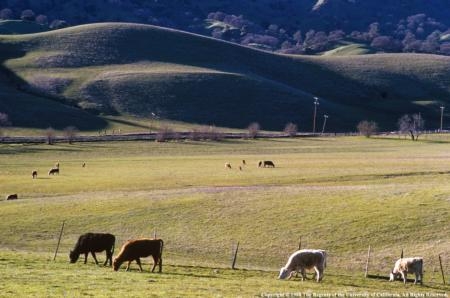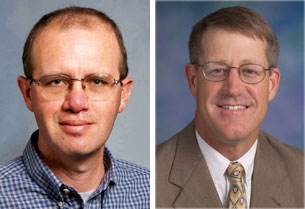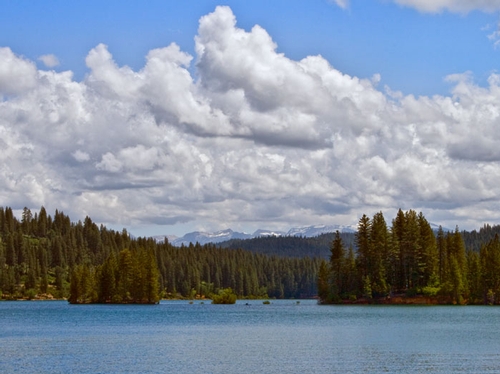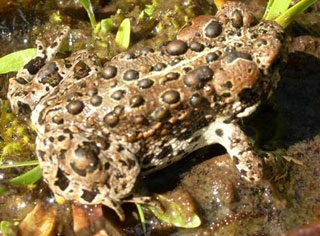Posts Tagged: Ken Tate
Yosemite toad and cattle use the Sierra Nevada landscape differently
A five-year study of Yosemite toad populations in an area fenced off from cattle has shown that exclusion from grazing doesn't help the endangered amphibian, reported Kate Campbell in AgAlert.
"The toads use water areas and the cattle use drier meadow areas, which provide better forage," said Ken Tate, UC Cooperative Extension specialist in the Department of Plant Sciences at UC Davis.
The study, "Determining the Effects of Cattle Grazing Treatments on Yosemite Toads in Montane Meadows," found "no benefit of fencing to Yosemite toad populations." Researchers said their results "do not support previous studies that found a negative impact of grazing on amphibian populations."
The Yosemite toad was once among the most prevalent amphibians in the high Sierra including Yosemite National Park, where it was first discovered and after which it is named, according to a UC Davis news release. But its population and habitat has declined sharply since the early 1980s, disappearing from much of its historic range — meadows at elevations between 6,500 and 11,500 feet from Alpine to Fresno counties.
Besides grazing, other possible reasons for the amphibian's decline include habitat modifications, disease, invasive species, climate change and pesticides, the AgAlert article said.
Combined with other recent studies of water quality and meadow vegetation grazed areas, the research shows that conditions are improving and compatibility between livestock production and other ecosystem services provided by forests are increasing, Tate said.
More information about the studies can be found on the Rangeland Watershed Laboratory website.
Ranchers view UCCE test plots during spring range tour
UC Cooperative Extension range research was featured at a field day Saturday in Tehama County, reported Julie Johnson in the Corning Observer.
Josh Davy, UCCE advisor in Tehama County, reviewed test plots were 60 varieties of annual and perennial range grasses were growing. Ken Tate, UCCE specialist, and Leslie Roche, postdoctoral researcher, both in the Department of Plant Sciences at UC Davis, gave an update on their long-term grazing research projects evaluating the effects of multiple grazing treatments. Guy Kyser, UCCE specialist in the Department of Plant Sciences at UC Davis, talked about weeds.
Tony Turri, owner of the ranch that hosted the field day, said he has worked extensively with the UC Cooperative Extension.
"There are a lot of factors and organizations that are trying to harm the cattle industry," he said. "Events such as this are important in our ability to stay in cooperation with each other and provided education and information to keep us in business."

Medusahead, barb goatgrass and yellow starthistle were some of the weeds researchers discussed at the field day.
Scientists to minimize impact of High Sierra grazing
University of California, U.S. Forest Service and other agencies will work together to understand the impact of cattle grazing in the High Sierra and look for solutions to water quality problems, according to an article in the Sonora Union Democrat.UC Davis Cooperative Extension watershed specialist Ken Tate and interim director of the Western Institute for Food Safety and Security at UC Davis Rob Atwill will design and conduct the study. The first samples have already been collected.
In the story, writer Ashley Archibald reported that the scientists are seeking to fix problems, not just document them.
“It’s good to focus on what are the practices that can move us forward so everyone can enjoy the national forest since it has a multiple use mandate and is a resource for the public, and the public is pretty diverse," Atwill was quoted.
Scott Oneto, the director and farm advisor for the UC Cooperative Extension in Calaveras and Tuolumne counties, said the scientists are still looking for input on how to build a comprehensive study.
The California Farm Bureau Federation's weekly publication AgAlert
also weighed in on the new study. The paper said the scientists held a briefing for ranchers in Sonora where they explained their desire to acquire data to demonstrate the relationship between grazing on public lands and water quality requirements.
The article - written by AgAlert editor Kate Campbell - noted that the scientists will take multiple water samples from 48 different sites in the High Sierra over the next several months, with preliminary results available by the end of this year. Sites will include areas used for grazing and recreation.
Researchers respond to Sac Bee Sierra grazing story
UC Davis Cooperative Extension researchers Ken Tate and Rob Atwill responded to a story about High Sierra grazing published last month in the Sacramento Bee in the California Farm Bureau Federation's newspaper AgAlert.
The Sacramento Bee story suggested that cattle grazing in high-elevation areas of the Sierra Nevada causes water contamination. Following is an opening excerpt of Atwill and Tate's commentary. See the AgAlert link for the complete 600-word response:
"Our shared challenge is to continue to identify and enact grazing practices which reduce pollution risks, enhance watershed health and sustain agricultural enterprises.
"All of our local communities are reeling from budget blows and decreasing revenues. Our local rural communities depend on livestock grazing and associated businesses for a stable economy.
"Sustainable food production and natural resources are crucial to our state, country and world. We all depend upon healthy watersheds."

Ken Tate, left, and Rob Atwill.
Forest Service works with UC to ensure water quality
U.S. Forest Service regional forester Randy Moore said the agency and its collaborators take the quality of high Sierra water seriously, according to an op-ed article that ran in the Sacramento Bee over the weekend.
The op-ed came after a May 1 Sac Bee editorial encouraging the Forest Service to limit grazing to lower elevations.
Moore wrote that the Forest Service is working with the State Water Resources Control Board to develop a water quality management plan for California national forests. The plan will establish best-management practices for controlling non-point source pollution like that produced by grazing cattle.To develop the practices, Moore said the agencies are looking at a large body of peer-reviewed literature examining the relationship between livestock and water quality. The studies were conducted by respected environmental researchers, he wrote, specifically naming UC Davis Cooperative Extension specialists Ken Tate and Rob Atwill.
UC Davis researchers have offered to work with the Forest Service to design monitoring and research that is scientifically credible and provides information that will ensure the safety and quality of watersheds, the op-ed says.

A lake in the high Sierra. (Photo: Mike Poe.)

